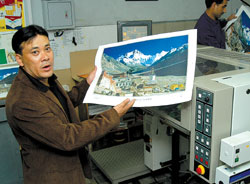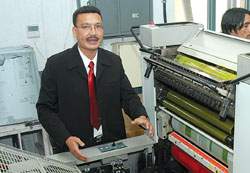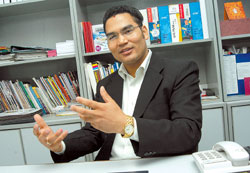|
|
From a country that used to spend Rs 80 million hard currency every year till a decade ago to get printing jobs done in India and Thailand, Nepal today is nearly self-sufficient in printing.
The growth in the media post-1990 was the initial catalyst. As newspapers improved production quality, the advertising industry kept pace with creativity and this had a spillover effect on the rest of the industry. By the end of the 1990s, publishers imported state-of-the-art printing machines to churn out world-class magazines.
|
|
The slump came in 2001-3 when economic stagnation hit advertising and this had a chain reaction in media and then on the printing industry. Because this coincided with heavy investment in new printing equipment, many presses felt the painful strain of keeping up with bank loans. But most weathered the storm by diversifying and in some cases also taking on export jobs.
The fact that Nepal has its own magazine devoted to the printing industry must mean that the sector has come of age. Sunil Shrestha of Wordscape launched Print Comm to foster quality in the sector. "Nepali clients need to be educated about quality and be willing to pay for it."
|
|
| We offer the best quality products when it comes to printing but we are still struggling with our outdated binding technology, which is why we cannot print large quantities in one go. - Amar Shakya, Sewa Press |
Wordscape also publishes what everyone agrees is Nepal's best-designed magazine, ECS, which caters to Kathmandu's expatriate community. ECS is printed at Jagadamba Press, which has been around for 50 years and started modernising with state-of-the-art equipment ten years ago.
"It was difficult in the beginning to convince customers that if they wanted quality and reliability they had to pay slightly more but it's much easier now," says Jagadamba's Narayan Poudel, "with the ceasefire volume is also picking up again."
|
|
| Challenges still remain but we have big plans for the future, which includes expanding to full automatic 28X40 inches machine. - Gautam Shrestha, Jagadamba Press |
Jagadamba has the country's only heat-set web machine that can print at 35,000 copies per hour. It now prints 15 newspapers and magazines besides Himalmedia's own Nepali Times,
Himal Khabarpatrika and Wave magazine. Indeed, most printers are now working overtime to keep up with demand for new products like promotion posters, calendars, magazines and annual reports.
Laxmi Bank has pioneered turning bland annual reports into works of art. Says CEO Suman Joshi: "For us, the annual report is a passionate project every year and we believe it reinforces our brand much more than a regular ad."
It was Jang Bahadur Rana that brought in Nepal's first press in 1851 on his return from his visit to England and France to print Gorkhapatra.
|
|
| Scan Pro introduced colour separation and computer through plate (CtP) technologies for the first time in Nepal. Now our customers get higher quality and economical pre-press products. - Om Pradhan, ScanPro |
Today, there are more than 100 printing presses across Nepal. Many of them not only have modern machines but are now also investing in top-of-the-line pre-press equipment like imagesetters and computer-to-plate (CtP) technology.
CtP removes one stage in the printing process by eliminating the need for plastic film, reducing cost and generally speeding things up. Four companies already have CtPs and more are in order. Says Om Pradhan of ScanPro: "What we can now offer with CtP is rapid turn around at much lower cost and a much better final
print quality."
With so much achieved in so little time, it may be tempting for Nepal's printers to rest on their laurels. But the field is still wide open and there are lots of areas where no one has yet ventured. Security printing of bank notes, bonds and stamps is one. Labelling and packaging could do with more investment as the economy grows.
And if tourism takes off again there will be in-flight magazines, post cards, posters and brochures. The good news is that with the improvement in pre-press and design, these products will be as good as the world has to ofer







